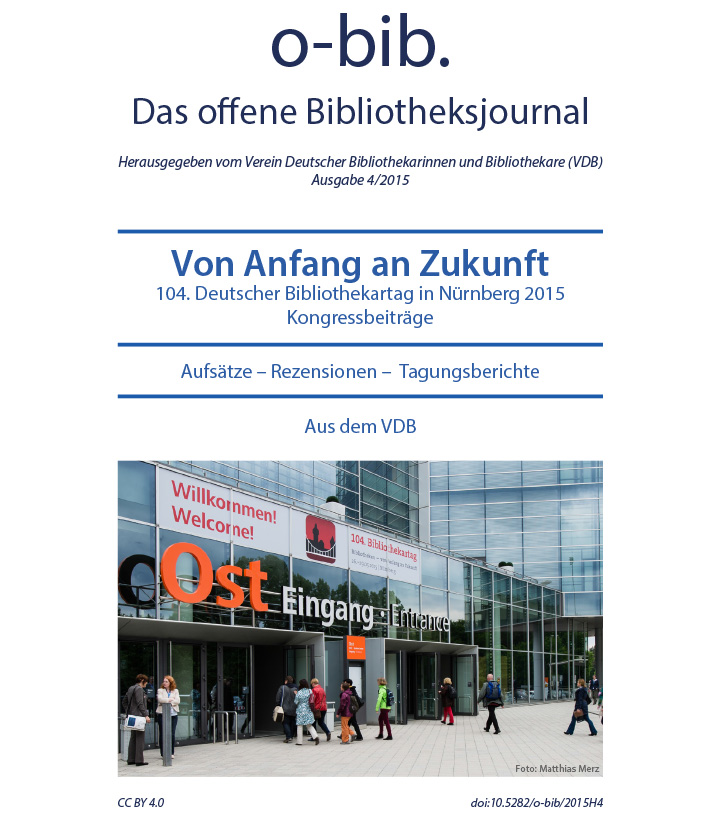10 gute Gründe für eine systematische Zusammenarbeit von Bibliotheken und Volkshochschulen
DOI:
https://doi.org/10.5282/o-bib/2015H4S34-42Abstract
Anhand von 10 Thesen wird vorgestellt, warum die engere Zusammenarbeit von Volkshochschulen und öffentlichen Bibliotheken sinnvoll ist und letztlich beide Einrichtungen stärkt. In Nürnberg hat die Stadt neue Wege beschritten, indem sie ihre Stadtbibliothek und die
Volkshochschule (Bildungszentrum) organisatorisch zusammengefasst hat. Beide Einrichtungen haben unterschiedliche Kernkompetenzen, aber auch viele Gemeinsamkeiten. Beide verstehen sich als Bildungs- und Kulturorte, beide befördern das Lernen im Lebenslauf u.v.a.m.
Der Vortrag geht sowohl auf Erfahrungen als auch auf Herausforderungen mit der neuen Organisationsform ein. Zudem werden zukünftige Entwicklungsperspektiven in der kommunalen Bildungslandschaft aufgezeigt.
The ten arguments put forward in this presentation illustrate why a closer cooperation between community education centres and public libraries makes sense and, ultimately, strengthens both institutions. The City of Nuremberg has ventured onto new paths by consolidating the organisation of the municipal library and the community education centre (Bildungszentrum). Both institutions have different core competencies, but also many similarities. Both see themselves as places of education and culture, both promote lifelong, continuing education and much more.
The presentation elaborates on both the experiences and the challenges that come along with the new form of organisation. The speakers also highlight the future development perspectives for the community education infrastructure.
Literaturhinweise
- Dogliani, Sergio: Innovation an den Bedürfnissen der Bevölkerung ausrichten: Die Idea Stores in London. In: Olaf Eigenbrodt; Richard Stang (Hg.): Formierung von Wissensräumen. Optionen des Zugangs zu Information und Bildung, Berlin/Boston: de Gruyter Saur, 2014, S. 124–137.
- Eckart, Wolfgang: Der Bildungscampus Nürnberg. Ein Beitrag zur Gestaltung kommunaler Bildungslandschaft. In: Timm Feld u.a. (Hg.): Engagierte Beweglichkeit. Weiterbildung in öffentlicher Verantwortung. Festschrift für Klaus Meisel, Wiesbaden: Springer VS, 2013, S. 49–67.
– Klemm, Ulrich: VHS als bürgerschaftlicher Ort der Daseinsvorsorge Präsentation. Sächsischer
Volkshochschulverband, 26.–28.11.2014. http://www.vhs-leipzig.de/fileadmin/user_upload/ak_gvhs/Klemm_Erwachsenenbildung_2025.pdf (10.11.2015).
– Rabofski, Birgit u.a.: Information Innovation Inspiration: Das Bildungshaus in Wolfsburg als neuer Prototyp eines Zentrums für lebenslanges Lernen. In: Olaf Eigenbrodt; Richard Stang (Hg.): Formierung von Wissensräumen. Optionen des Zugangs zu Information und Bildung, Berlin/Boston: de Gruyter Saur, 2014, S. 138–147.
– Schuld, Knud: Die Bibliothek als innovative Bürgerplattform. In: BuB − Forum Bibliothek und Information 67 (2015), H. 4, S. 206–210.
– Stang, Richard; Hesse, Claudia (Hg.): Learning Centres. Neue Organisationskonzepte zum lebenslangen Lernen in Europa, Bielefeld: Bertelsmann, 2006.
Veröffentlicht
Zitationsvorschlag
Ausgabe
Rubrik
Lizenz
Copyright (c) 2015 Elisabeth Sträter, Wolfgang Eckart

Dieses Werk steht unter der Lizenz Creative Commons Namensnennung 4.0 International.







